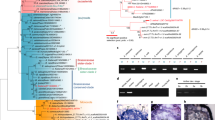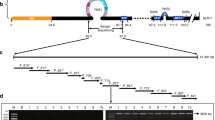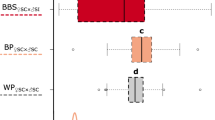Abstract
GENICALLY inherited a synapsis is sometimes met with in a number of plant species, according to observations made by various workers during the last ten years. The most remarkable cases were recently reviewed by Prakken1. In a number of the oases observed it was, however, not possible to say with any certainty if the lack of chiasmata at meiosis really was genically determined or not. One of these uncertain cases was observed by Yamamoto2 in a Japanese male plant of Rumex Acetosa, but in Rumex angiocarpus I observed3 asynapsis, which most possibly is of the modificatory type.
This is a preview of subscription content, access via your institution
Access options
Subscribe to this journal
Receive 51 print issues and online access
$199.00 per year
only $3.90 per issue
Buy this article
- Purchase on Springer Link
- Instant access to full article PDF
Prices may be subject to local taxes which are calculated during checkout
Similar content being viewed by others
References
Prakken, R., Hereditas, 29, 475 (1942).
Yamamoto, Y., "Botany and Zoology", 2, 1160 (1934).
Löve, A., Hereditas, 30, 1 (1944). (Diss. Lund, 1943).
Ono, T., Sci. Rep. Tohoku Imp. Univ., Ser. 4, 10, 41 (1935).
Yamamoto, T., Mem. Coll. Agric. Kyoto Imp. Univ., 43, 1 (1938).
Winge, Ö., Hereditas, 15, 127 (1931).
Author information
Authors and Affiliations
Rights and permissions
About this article
Cite this article
LÖVE, A. A Y-linked Inheritance of Asynapsis in Rumex Acetosa. Nature 152, 358–359 (1943). https://doi.org/10.1038/152358b0
Issue Date:
DOI: https://doi.org/10.1038/152358b0
This article is cited by
-
Mutant genes affecting higher plant meiosis
Theoretical and Applied Genetics (1985)
-
Cytogenetics of synaptic mutants in higher plants
Theoretical and Applied Genetics (1981)
-
A sex-linked and sex-limited white-eyed mutation of the blow-fly (Calliphora erythrocephala)
Journal of Genetics (1947)
Comments
By submitting a comment you agree to abide by our Terms and Community Guidelines. If you find something abusive or that does not comply with our terms or guidelines please flag it as inappropriate.



